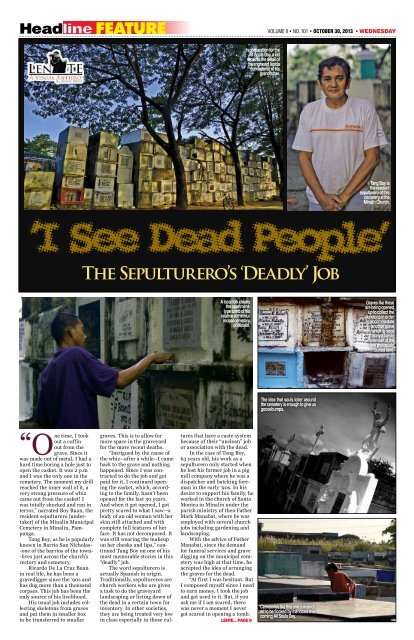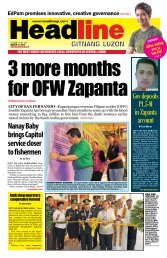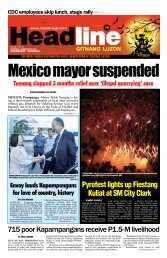Create successful ePaper yourself
Turn your PDF publications into a flip-book with our unique Google optimized e-Paper software.
FEATUREVOLUME II • NO. 101 • OCTOBER 30, 2013 • WEDNESDAYIn preparation for theAll Souls Day, a kidrepaints the detail ofthe engraved lapida(tombstone) of hisgrandfather.Tang Boy isthe residentsepulturero of thiscemetery at theMinalin Church.The Sepulturero’s ‘Deadly’ JobA local folk cleansthe apartmenttypetomb of hisrelative at the municipalcemeteryof Minalin.Graves like theseare being openedup to collect theskeletons in orderto accommodateanother gravewhich is mostlikely a familymember of theone previo<strong>us</strong>lyburied here.The idea that souls loiter aroundthe cemetery is enough to give <strong>us</strong>goosebumps.time, I tookout a coffinout from the“Onegrave. Since itwas made out of metal, I had ahard time boring a hole j<strong>us</strong>t toopen the casket. It was 2 p.mand I was the only one in thecemetery. The moment my drillreached the inner wall of it, avery strong pressure of whizcame out from the casket! Iwas totally shocked and ran interror,” narrated Boy Buan, theresident sepulturero (undertaker)of the Minalin MunicipalCemetery in Minalin, Pampanga.Tang Boy, as he is popularlyknown in Barrio San Nicholas--one of the barrios of the town--lives j<strong>us</strong>t across the church’srectory and cemetery.Ricardo De La Cruz Buanin real life, he has been agravedigger since the ‘90s andhas dug more than a tho<strong>us</strong>andcorpses. This job has been theonly source of his livelihood.His <strong>us</strong>ual job includes collectingskeletons from gravesand put them in smaller boxto be transferred to smallergraves. This is to allow formore space in the graveyardfor the more recent deaths.“Intrigued by the ca<strong>us</strong>e ofthe whiz--after a while--I cameback to the grave and nothinghappened. Since I was contractedto do the job and gotpaid for it, I continued openingthe casket, which, accordingto the family, hasn’t beenopened for the last 30 years.And when it got opened, I gotpretty scared to what I saw—abody of an old woman with herskin still attached and withcomplete full features of herface. It has not decomposed. Itwas still wearing the makeupon her cheeks and lips,” continuedTang Boy on one of hismost memorable stories in this“deadly” job.The word sepulturero isactually Spanish in origin.Traditionally, sepultureros arechurch workers who are givena task to do the graveyardlandscaping or listing down ofthe dead in a certain town forinventory. In other societies,they are being treated very lowin class especially in those culturesthat have a caste systembeca<strong>us</strong>e of their “unclean” jobor association with the dead.In the case of Tang Boy,63 years old, his work as asepulturero only started whenhe lost his former job in a pigmill company where he was adispatcher and batching foremanin the early ‘90s. In hisdesire to support his family, heworked in the church of SantaMonica in Minalin under theparish ministry of then FatherMark Manabat, where he wasemployed with several churchjobs including gardening andlandscaping.With the advice of FatherManabat, since the demandfor funeral services and gravedigging on the municipal cemeterywas high at that time, heaccepted the idea of arrangingthe graves for the dead.“At first I was hesitant. ButI composed myself since I needto earn money. I took the joband got <strong>us</strong>ed to it. But, if <strong>you</strong>ask me if I am scared, therewas never a moment I nevergot scared in opening a tomb.LENTE... pagE 9Cemeteries like this one is expectedto be flocked by the locals thiscoming All Souls Day.

















